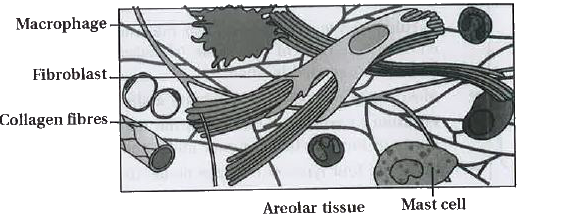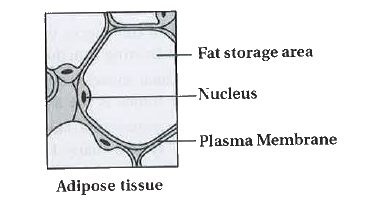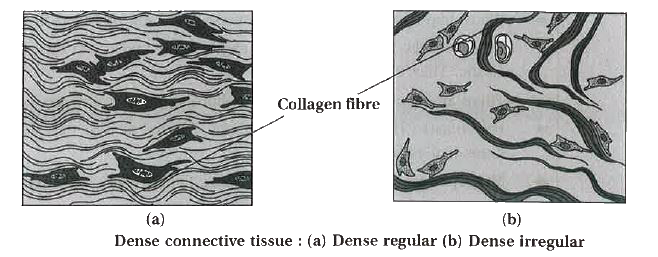Describe characteristics and types of connective tissue.Solution in Gujrati
They perform special function of linking and supporting other tissues/organs of the body. Structure : This tissue has less number of cells. It has more amount of intercellular fluid. This fluid is created by cells of tissue. New cells are formed from pre-existing cells. Cells of this tissue secrete structural protein fibres (except blood tissue). It is called collagen or Elastin. These fibres provides strength, flexibility and elasticity. These cells also secrete polysaccharide which gets deposited between cells and fibres and acts as matrix. Types of connective tissue : Connective tissue is classified into three types : (i) Loose connective tissue (ii) Dense connective tissue (iii) Specialised connective tissue. (i) Loose connective tissue : Loose connective tissue has cells and fibres loosely arranged in a semi-fluid ground substance. There are two type of loose connective tissue. (a) Areolar connective tissue, (b) Adipose tissue (a) Areolar connective tissue : Location : This tissue is found in the gastrovascular cavity, peritoneum and in mesentery which is surrounding the intestines and in walls of arteries and at many other places. Structure : The matrix fluid of this tissue is comparatively thick. In matrix network of fibres, they are collagenous and are of protein. Fibres are of two types : White fibres and yellow fibres. White fibres : They are made up of collagen and elastic. They can toilerate stretch and pressure. White fibres are wavy and new branched and are arranged in groups. Yellow Fibres : They are nonbranched, single and made up of elastin material and elastic. They can not bear stretch and pressure. There are three types of cells in it : fibroblasts, macrophages and mast cells. Fibroblasts : They are irregular in shape, flat and possess processes. They form protein fibres like collagen and elastin. Macrophages : They are large irregular shaped cells. They perform phagocytosis of bacteria, large particles and decomposed material. Mast cells : They store inflammatory materials. They secrete three type of active materials : Heparin, Histamine and Serotonin.

(b) Adipose tissue : Adipose tissue is another type of loose connective tissue located mainly beneath the skin. The cells of this tissue are specialised to store fats. The excess of nutrients which are not used immediately are converted into fats and are stored in this tissue.

(ii) Give . information about tendons and ligaments. Dense connective tissues : Fibres and fibroblasts are compactly packed in the dense connective tissues or irregular pattern and are called dense regular and dense irregular tissues. In the dense regular connective tissues, the collagen fibres are present in rows between many parallel bundles of fibres. Tendons : That attach skeletal muscles to bones. Ligaments : That attach one bone to another. Dense irregular connective tissue : This tissue has fibroblasts and many fibres (mostly collagen) that are oriented differently.

(iii) Specialised connective tissue : (a) Cartilage (b) Bones and (c) Blood are various types of specialised connective tissue. (a) Cartilage tissue : The intercellular material of cartilage is solid and pliable and resists compression. Cells of this tissue (chondrocytes) are enclosed in small cavities within the matrix secreted by them. Most of the cartilages in vertebrate embryos are replaced by bones in adults. Location : Cartilage is present in the tip of nose, outer ear joints, between adjacent bones of the vertebral column, limbs and hands in adults. "* There are four types of cartilage tissue, (i) Hyaline cartilage (ii) White fibrous cartilage (iii) Yellow elastic cartilage (iv) Cartilage fused with calcium. (b) Bones tissue : Bones tissue is also a skeletal tissue. It is solid, brittle and in-elastic. It has ossein fluid and different salts in its matrix. Its cells are called osteocytes. The structure of bone is very complex. It gives strength to bones. It is a main tissue of the body. It gives structural frame to the body. Bones support and protect softer tissues and organs. The bone cells are present in the spaces called lacunae limb bones such as the long bones of legs, serve weight bearing function. They also interact with skeletal muscles attached to them to bring about movements. The bone marrow in some bones is the site of production of blood cells. In bones of mammals, many structure like pillars are seen. It is called as Haversian system. In each Haversian system many Lamellae of bone material form concentric rings around large longitudinal canals within the bone tissue. These canals are called Haversian canals.

(c )Blood tissue : Blood is a fluid connective tissue containing plasma, red blood cells, white blood cells and platelets. It is the main circulating fluid that helps in the transport of various substances
Topper's Solved these Questions
- STRUCTURAL ORGANISATION IN ANIMALSBOOK - KUMAR PRAKASHANCHAPTER - STRUCTURAL ORGANISATION IN ANIMALSEXERCISE - SECTION-B (Difference/Scientific Reason)
9 Videos
- STRUCTURAL ORGANISATION IN ANIMALSBOOK - KUMAR PRAKASHANCHAPTER - STRUCTURAL ORGANISATION IN ANIMALSEXERCISE - SECTION-C(DEFINITIONS /EXPLANATION-TERM/LOCATION-FUNCTION)
40 Videos
- SAMPLE QUESTION PAPER FOR SECOND EXAMBOOK - KUMAR PRAKASHANCHAPTER - SAMPLE QUESTION PAPER FOR SECOND EXAMEXERCISE - SECTION - D
1 Videos
- THE LIVING WORLDBOOK - KUMAR PRAKASHANCHAPTER - THE LIVING WORLDEXERCISE - OBJECTIVE SECTION (FILL IN BLANKS)
9 Videos
Similar Questions
Simple Epithelium and Compound Epithelium
View SolutionLigaments
View SolutionExplain Double circulation with the help of chart.
View SolutionA .......... is a collection of pressed, dried and preserved plants mounted on ……..
View Solutionmention the characteristics of connective tissue.
View SolutionFine fibres in the matrix are characteristic of which type of connective tissue ?
View Solutionसंयोजी ऊतक क्या है ? किसी एक प्रकार के संयोजी ऊतक के कार्यसहित वर्णन करे ।
View Solutionविभज्योतकी ऊतक की विशेषताएँ बताओ ।
View Solutionतन्तुमय संयोजी ऊतक क्या है ? ये कितने प्रकार के होते है ? वर्णन करो ।
View Solutionसंयोजी ऊतक किसे कहते है ? ये कितने प्रकार के होते है ? प्रत्येक का वर्णन कीजिए ।
View SolutionBriefly describe the characteristics of meristermatic tissue.
View Solutionविभिन्न प्रकार के संयोजी ऊतकों का वर्णन कीजिए।
View SolutionWhich tissue is most common type in plants? Describe its characteristics.
View Solutionजन्तु ऊतक की विशेषताएं बताओं |
View SolutionDescribe the different types of connective tissues & give examples?
View Solution
